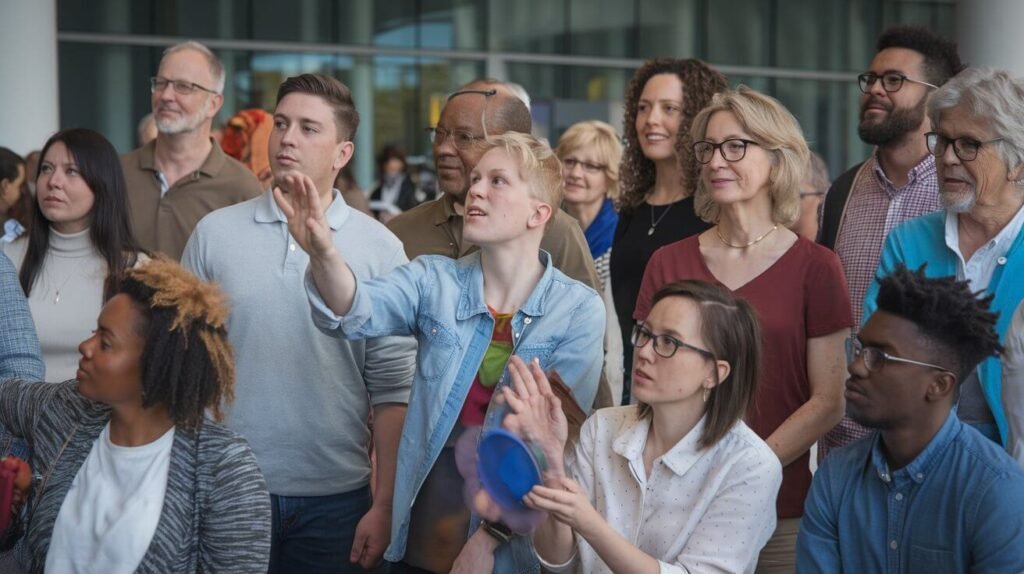Is There a Universal Sign Language? Top 4 Most Popular Sign Languages
When we think of communication, language often comes to mind. In many cultures, language is a vital part of expressing thoughts, emotions, and ideas. However, for people who are deaf or hard of hearing, communication takes a different form: sign language. Sign language is used by millions of people worldwide to communicate, but there’s often a question that arises: Is there a universal sign language?
In this article, we’ll explore whether a single universal sign language exists, how various sign languages have evolved, and why regional differences persist in sign communication.

Understanding Sign Language
To answer the question of whether a universal sign language exists, it’s essential to first understand what sign language is. Sign language is a visual form of communication that uses hand gestures, facial expressions, and body movements to convey messages. It is used by individuals who are deaf or hard of hearing as a primary or secondary mode of communication.

Each country or region has developed its own version of sign language, often shaped by its culture, history, and needs.
What Makes Sign Language Unique?

Unlike spoken languages, sign languages are not merely visual representations of spoken words. Instead, they have their own grammar, syntax, and structure, making them fully developed languages. For instance, American Sign Language (ASL) follows a different grammatical structure from English. This means that sign languages are not just a translation of spoken languages but are distinct languages in their own right.
Why Is There No Universal Sign Language?
The idea of a universal sign language seems appealing, especially considering how beneficial it would be for communication among deaf communities worldwide. However, several factors explain why such a universal system hasn’t emerged. Let’s dive deeper into these reasons.
1. Cultural and Regional Influences

One of the main reasons there is no universal sign language is the influence of culture and geography. Just like spoken languages, sign languages have evolved over time based on the unique needs of local communities.
These communities have developed their own signs for everyday objects, activities, and concepts, leading to regional variations. For example, the signs for “hello,” “thank you,” or “goodbye” can differ from one country to another, even if the language is fundamentally the same.
2. Historical Development

Sign languages have developed in response to historical events. In many countries, education for the deaf was initially isolated, leading to the formation of unique sign languages within specific communities or even schools.
For example, the French Sign Language (LSF) was the basis for the creation of American Sign Language (ASL). While there are similarities, each sign language has evolved differently based on local traditions, educational practices, and even the influences of other languages.
3. Deaf Communities’ Autonomy

Sign languages are deeply connected to the deaf community’s identity and culture. Many deaf communities take pride in their unique sign language as a symbol of their culture and heritage.
The development of a single universal sign language would likely face resistance from communities that value their own linguistic traditions. This desire to preserve cultural identity has contributed to the persistence of regional sign languages.
Must Read: How to Search for the Biggest Businesses in a Certain Area: 10 Powerful Steps to Search
The Most Common Sign Languages
While a universal sign language doesn’t exist, there are a few prominent sign languages that are widely used around the world. These include:
1. American Sign Language (ASL)
American Sign Language is one of the most commonly used sign languages in North America. It is primarily used in the United States and parts of Canada. ASL has its roots in French Sign Language and has evolved to incorporate influences from other languages and cultures.
2. British Sign Language (BSL)
British Sign Language is used by the deaf community in the United Kingdom. It is different from ASL, despite both languages using the same English-based alphabet. The signs in BSL and ASL vary considerably, which further emphasizes the lack of a universal sign language.

3. French Sign Language (LSF)
French Sign Language is one of the oldest sign languages and has had a significant influence on the development of other sign languages, such as ASL. LSF remains widely used in France and other Francophone countries.
4. International Sign Language
International Sign (IS) is a simplified form of sign language that’s used in international meetings, conferences, or events where people from different sign language backgrounds gather. While it isn’t a fully developed language like ASL or BSL, it serves as a bridge for communication between people from different sign language communities.
The Need for a Universal Sign Language
Despite the variations in sign languages, the concept of a universal sign language continues to be appealing, especially in globalized settings. Here are some reasons why people believe a universal sign language could benefit the deaf community worldwide.
1. Improved Communication Across Borders
A universal sign language could facilitate communication between deaf individuals from different countries, especially during international events, conferences, or emergencies. It would remove the need for interpreters or translation services, making cross-border communication much smoother.
2. Standardization in Education
In countries where deaf education systems are underdeveloped or inconsistent, a universal sign language could provide a standardized method of communication. This could improve access to education and services for the deaf community, especially in developing countries.

3. Bridging Gaps in the Global Deaf Community
Deaf communities around the world share similar challenges, but without a universal sign language, communication between them can be difficult. A global sign language could help create stronger bonds and a sense of unity within the global deaf community.
Challenges of Creating a Universal Sign Language
Creating a universal sign language, however, presents a significant set of challenges. These challenges stem from both linguistic and cultural factors.
1. Linguistic Diversity
Sign languages, like spoken languages, are rich with regional dialects, slang, and idioms. Attempting to create a standardized language that appeals to every community could result in the loss of important linguistic diversity. Local variations of sign languages hold deep cultural significance, and any effort to create a universal system might overlook or marginalize these unique expressions.

2. Resistance from Deaf Communities
Many deaf communities take great pride in their own language and culture. Forcing a universal sign language upon them could lead to feelings of erasure or cultural loss. These communities have spent generations developing their sign languages, and some may resist the idea of a single universal system, seeing it as a threat to their identity.
3. Logistical and Practical Issues
The logistical and practical challenges of creating a universal sign language are also significant. It would require worldwide cooperation, and each country’s education system would need to adopt and teach the new language. This would take time and resources, and would likely be met with challenges in implementation.
Also Read: What Does Total Travel Mean in Switches? 3 Essential Types of Switches and Their Impressive Total Travel
What Is the Role of International Sign Language?
While there is no universal sign language, International Sign (IS) is one step closer to a global method of communication for the deaf. IS is used in specific international settings and allows for basic communication across diverse sign languages. It draws from several sign languages and uses simplified grammar, making it easier for individuals from different countries to communicate.

Is International Sign Language a Step Towards Universality?
International Sign is often seen as a solution to communication barriers, but it isn’t meant to replace national sign languages. Rather, it serves as a common ground in situations where people who use different sign languages come together. It’s not a universal language but could be an important tool for deaf individuals in global settings.
What Is the Most Universal Sign Language?
There is no truly “universal” sign language. However:

- International Sign (IS): This is the closest to a universal sign language. It’s used in international meetings, events, and by the World Federation of the Deaf. It’s not a full language but a pidgin-like system combining elements of various sign languages for easier communication.
Should I Learn ASL or BSL?
Choosing between American Sign Language (ASL) and British Sign Language (BSL) depends on your location and goals:
- Learn ASL if you live in or interact frequently with people in the USA, Canada, or other regions influenced by ASL (e.g., the Philippines).
- Learn BSL if you are in the UK or plan to work closely with the British Deaf community. Consider the community you’re likely to engage with and the resources available for learning.
Is It Possible to Have a Universal Sign Language?

Creating a universal sign language is theoretically possible but practically challenging because:
- Sign languages naturally evolve with local cultures and communities.
- Variations in grammar, syntax, and vocabulary make it difficult to standardize. Efforts like International Sign aim to bridge the gap, but it remains limited in scope and fluency.
Why Is There Not a Global Sign Language?
On platforms, communities discuss sign languages extensively, but no single “universal” sign language is endorsed. Popular subreddits include:
- r/ASL: Focused on American Sign Language.
- r/signlanguage: Discusses various sign languages and topics like International Sign.
- Cultural Differences: Like spoken languages, sign languages develop organically within specific cultures.
- Historical Development: Communities developed sign languages independently before widespread global communication.
- Practical Barriers: It would be difficult to replace or unify the hundreds of existing sign languages worldwide.
Is There a Universal Sign Language in the USA?
No, there is no universal sign language in the USA. American Sign Language (ASL) is the primary language used by the Deaf community in the United States and parts of Canada.

Why Is Sign Language Not Universal?
- Independent Evolution: Different Deaf communities developed sign languages independently, leading to variations.
- Cultural Expression: Sign languages reflect the unique cultural context of their regions.
- Practical Challenges: Creating a universal system would require consensus and replacing deeply rooted linguistic traditions.
Is Sign Language Universal in Spanish-Speaking Countries?

No, Spanish-speaking countries use different sign languages. For example:
- Lengua de Señas Española (LSE): Used in Spain.
- Lengua de Señas Mexicana (LSM): Used in Mexico. Each is distinct and not interchangeable with Spanish or other sign languages.
How Many Sign Languages Are There?
There are over 300 distinct sign languages worldwide, recognized by linguists and used by Deaf communities.
Most Common Sign Language

- American Sign Language (ASL): Widely used in North America and parts of Africa and Asia.
- British Sign Language (BSL): Used in the UK.
- French Sign Language (LSF): Influential in Europe and parts of Africa.
- Chinese Sign Language (CSL): One of the most used by population size.
Universal Sign Language Words
Some signs, especially those based on universally understood concepts, are more likely to be recognized across languages (e.g., “OK,” “yes,” “no,” “stop”). However, even these can vary in execution.
Gestun/International Sign Language

- Gestuno: An early attempt at creating a universal sign language. It evolved into International Sign (IS), a simplified system for cross-linguistic communication.
- While useful, IS is not as nuanced as native sign languages.
Conclusion: The Complexity of a Universal Sign Language
The question of whether there is a universal sign language doesn’t have a simple answer. While the idea is appealing, the reality is that linguistic, cultural, and practical challenges make it unlikely that a single, universal sign language will emerge. Instead, regional sign languages continue to thrive, each with its own rich history and cultural significance. However, tools like International Sign Language provide a form of common communication across borders, allowing deaf individuals to connect on a global scale.
Sign language is a vital and beautiful form of communication, and despite the lack of a universal system, the deaf community continues to create meaningful connections, share experiences, and overcome barriers.
FAQs
What is the most widely used sign language in the world?
American Sign Language (ASL) is one of the most widely used sign languages, especially in North America.
Is International Sign Language the same as American Sign Language?
No, International Sign is a simplified form used in international events, while ASL is a full language with its own grammar and vocabulary.
Can I learn sign language online?
Yes, there are many online resources, courses, and apps available to help individuals learn sign language.
Are sign languages the same in all countries?
No, each country has developed its own version of sign language, which may differ significantly from others.
How does International Sign differ from regional sign languages?
International Sign uses simplified vocabulary and grammar to enable communication between users of different sign languages, but it isn’t a fully developed language.

